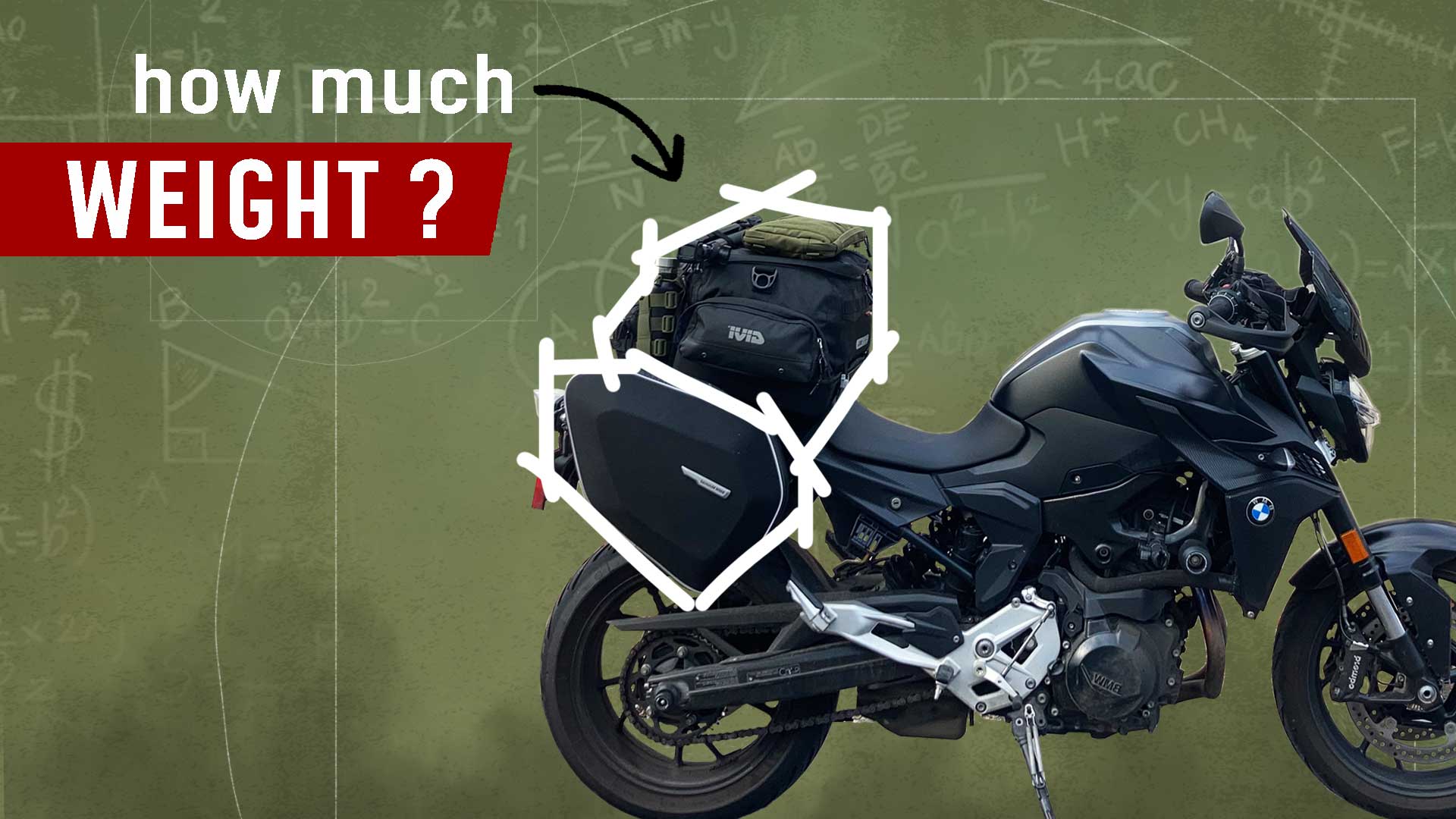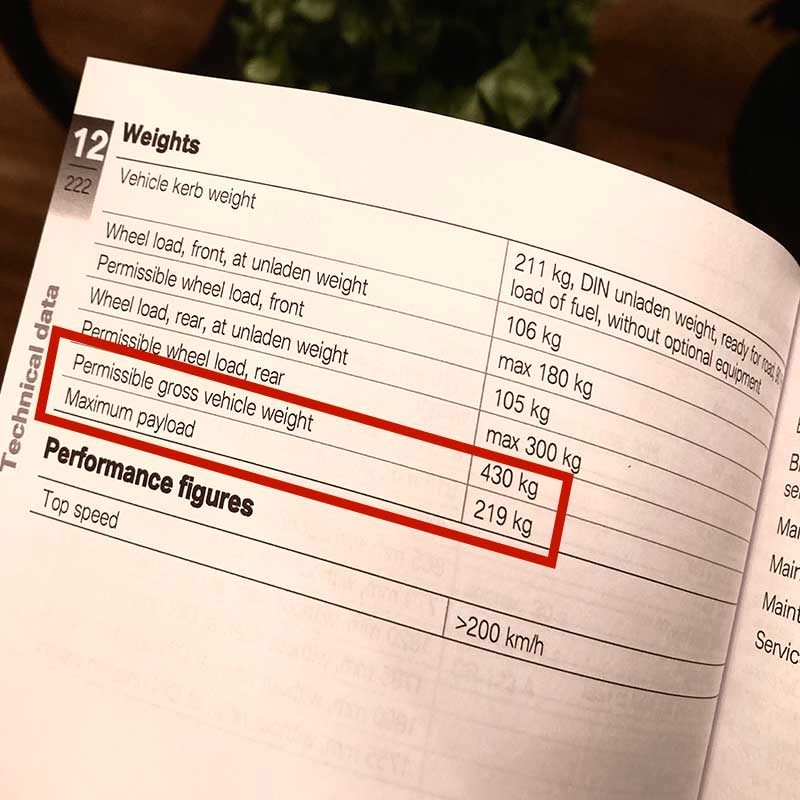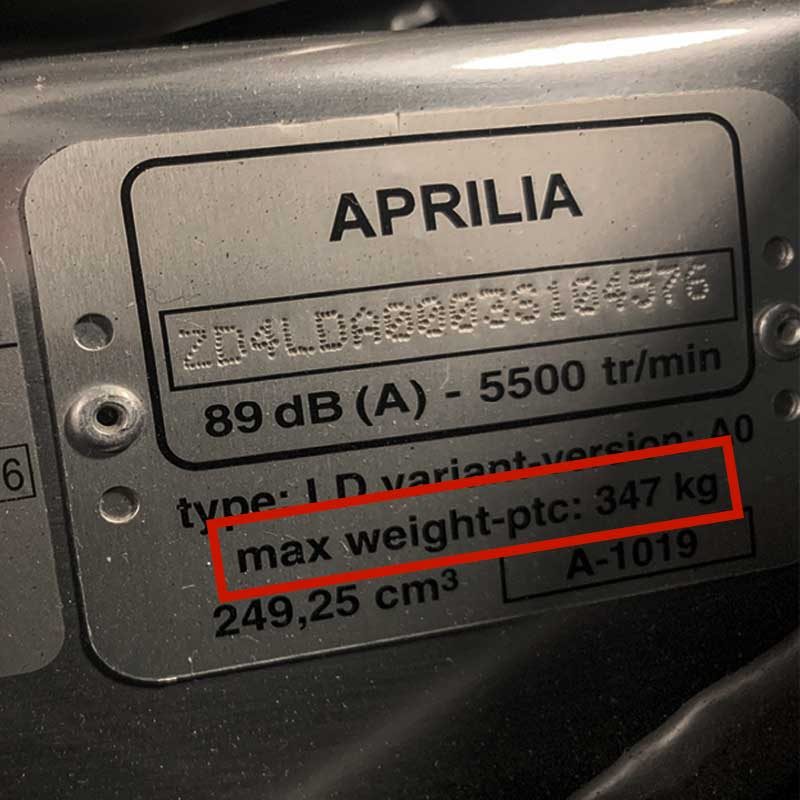How much weight can you carry on your motorcycle?
Are you in the process of planning your next long distance motorcycle road trip? Let’s say you’ve already picked the best route and you are now going through your packing list. You want to be comfy while on the road. But you also need to be safe. That includes knowing how much load your motorcycle can handle.

Most motorcycles can safely carry between 350-500 lb with the right weight distribution. This combines the rider, the passenger and all touring items. To determine your motorcycle’s maximum cargo capacity, you must extract the Wet Weight of your motorcycle from the Gross Vehicle Weight Rating (GVWR).
If this is your first time searching for an answer to this question, you might be in for a surprise. I know I was. So, instead of taking a guess on how much weight your bike should be able to carry (and how much weight you are actually bringing with you), let’s go through the whole calculation. And be accurate.
What does “Motorcycle Payload Capacity” mean?
The Payload Capacity is a measurement that describes the maximum cargo weight that your motorcycle can carry, including:
the rider with gear (helmet, boots, jacket, etc.)
the passenger (if any)
the luggages (including racks and mounting system)
the travel items (everything inside the luggages)
any additional accessories (crash bars, spare fuel, etc.)
The Payload Capacity varies from one motorcycle to another but it usually ranges between 350-500 lb. As an example, a BMW R1250GS has a high payload capacity of 478 lb while a Honda Goldwing can carry up to 423 lb and the Yamaha MT-09 is limited to 366lb.
Examples of Weight Specs for Different Types of Motorcycle
| GVWR (1) | Wet/Curb Weight (2) | Payload Capacity (3) | |
|---|---|---|---|
| BMW R1250GS (2022) | 1069 lb | 591 lb | 478 lb |
| Honda Goldwing (2022) | 1270 lb | 847 lb | 423 lb |
| Yamaha MT-09 (2022) | 783 lb | 417 lb | 366 lb |
| (1) Gross Vehicle Weight Rating = maximum safe mass (2) Wet/Curb Weight = road ready with all fluids (3) Payload Capacity / Max Weight Capacity = rider (+ passenger) + cargo + accessories |
|||
How to calculate the max cargo weight for your motorcycle?
In case your owner’s manual doesn’t specify the “Payload Capacity” (or maximum cargo weight) for your motorcycle, you will have to do the math yourself. And here’s the formula:
GVWR (Gross Weight) – Wet/Curb Weight = Payload Capacity (Maximum Cargo Weight)
The Gross Vehicle Weight Rating (GVWR) is the manufacturer’s stated maximum safe mass of the motorcycle, including its own mass and everything it carries.
The Wet/Curb Weight is a weight measurement that describes the motorcycle in ready-to-ride condition. It includes the weight of the motorcycle itself, the fuel, all necessary oil, coolant, hydraulic fluids and battery. Depending on the manufacturer, the weight of the fuel can range from a half tank to a full tank.
To calculate the Payload Capacity, you take the GVWR and subtract the Wet Weight.
Where can you find your motorcycle’s GVWR?
Pretty much all Owner’s Manuals indicate your motorcycle’s Wet/Curb Weight. That’s an easy find. However, figuring out the Gross Vehicle Weight Rating (GVWR) tends to be a more adventurous matter. If not included in the Owner’s Manual, you should find your bike’s GVWR either:
on the Vehicle-Identification-Number (VIN) plate/decal located somewhere on the steering neck or a nearby frame
in the Service/Repair Manual
on the manufacturer’s website
at a dealership (in their top secret computer)
Also, you should know that, as if it wasn’t complicated enough, the terminology GVWR is rarely used, but rather “permissible gross vehicle weight” or “max weight – ptc”.


How much weight can your motorcycle handle?
At first glance, the Payload Capacity for your motorcycle may look like a high and manageable number. But you really need to look further into this. When you actually include every element of your cargo in the calculation, it adds up fairly quickly and before you know it, you’ve reached (or surpassed) the weight limit.
So, let’s break this down with different loading scenarios.
How Much Weight Your Motorcycle Can Handle VS How Much Cargo You Actually Carry
| Cargo Items | Scenario A | Scenario B | Scenario C |
|---|---|---|---|
| Rider | 170 lb | 200 lb | 210 lb |
| Rider’s Gear | 20 lb | 20 lb | 20 lb |
| Passenger with Gear | 165 lb | x | 185 lb |
| Hard Aluminum Luggages (side and tail boxes) with racks | 35 lb | x | 35 lb |
| Soft Luggages (side and tail bags) with racks | x | 10 lb | x |
| Travel Items Including Long-Distance Tool Kit | 15 lb | 15 lb | 20 lb |
| Camping Equipment | x | 10 lb | x |
| Crash Bars | 20 lb | x | 20 lb |
| Other Accessories | 5 lb | 5 lb | 5 lb |
| Total Cargo | 430 lb | 260 lb | 495 lb |
This experiment demonstrates that if your bike’s max cargo weight leans more towards 350 lb, it will drastically restrict the amount of items you can carry. In this case, it is crucial to find ways to lower your cargo weight, such as choosing soft luggages over hard ones. Furthermore, it indicates that adding a passenger to the equation may result in overloading your motorcycle quite easily.
How to load cargo on your motorcycle the safe way?
Once you have established what is the Payload Capacity for your motorcycle and you have gone through the whole calculation to adequately evaluate the actual cargo weight for your trip, here are some crucial additional tips to load your motorcycle the safe way:
MINIMIZE THE CARGO WEIGHT – Pack light and pack smart, as explained in this article in which I go through the whole packing list and recommendations on how to organize your stuff in an efficient way.
BALANCE THE WEIGHT STRATEGICALLY – Pack the heaviest items as low and as far front as possible on the bike. And make sure both sides of the luggage are of even weight.
ADJUST THE MOTORCYCLE’S SUSPENSION – No matter how light your cargo is and how well balanced it is, if your rear suspension is not correctly set up, it could still have a major impact on the safe handling of your motorcycle.
DO A TEST RIDE – Before heading out on your road trip, go on a practice run and make sure you test it in all sorts of conditions: at a highway speed, riding up a hill, leaning into curves, making sudden stops. This will allow you to “feel” the bike, take note of any odd performance and make any necessary adjustments.
What are the risks associated with inadequately loading your motorcycle?
In addition to causing strain on your bike (suspension, brake, etc.) and extra wear on your tires, the main risks associated with overloading your motorcycle (or uneven weight) is to:
make it more difficult to maneuver at low speed
increase the probability for wobble / tank slapper.
